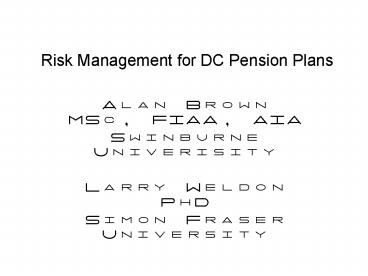Alan Brown MSc, FIAA, AIA - PowerPoint PPT Presentation
1 / 25
Title:
Alan Brown MSc, FIAA, AIA
Description:
Special Features of Long Term Horizon. Practicality of Short Term ... Swinburne Univerisity. abrown_at_labyrinth.net.au. Larry Weldon PhD. Simon Fraser University ... – PowerPoint PPT presentation
Number of Views:32
Avg rating:3.0/5.0
Title: Alan Brown MSc, FIAA, AIA
1
Risk Management for DC Pension Plans
- Alan Brown MSc, FIAA, AIA
- Swinburne Univerisity
- Larry Weldon PhD
- Simon Fraser University
2
Talk Outline
- Investment Environment - DC Plan
- Traditional Approach - Risk Mgt.
- Special Features of Long Term Horizon
- Practicality of Short Term Management
- Exponential Utility and Risk Adjustment
- Optimal Asset Class Mix
- Concluding Remarks
3
Investment Environment
- SFUs Defined Contribution Pension Plan
- No member choice until 2001
- 87 still in default plan.
- Heterogeneous mix in default plan.
- Usually long term in plan (25 yrs )
4
Asset Class Mix?
- Balance of Risk and Return
- Balance of Variability and Return ?
- Is Risk Variability?
5
Investment Risk
- Downside variability, over a particular time
period - How to quantize this?
- Depends on the time period
- What if 25 years or more?
6
(No Transcript)
7
Cumulative Market ReturnsCanada 1956-2004
Log Scale -gt
8
Experience 1956-2004
- Equities outperform bonds in every 25 year span.
What is risky? - Can it be counted on for the future?
- Simulation approach Mimic stochastic features of
the past without constraining the result
9
Calibration of Simulation
- Equities 10 pa
- Bonds 7 pa
- Daily changes
- Equities Exponential with mean .5,
- Up with prob .547
- Bonds Exponential with mean .3 for down
- Up with prob.544
- Bonds Gamma with mean .3 and shape 2 for up
10
Simulation 100, 25-year-periods
11
Big Picture
- Longer term investment -gt longer term returns are
realized - Pension investing is very long term.
- Equities will produce the greatest long term
returns (from risk premium).
12
100 equities for long term ?
- Legal liability in a bad year
- Election as trustee in jeopardy
- Fund Managers dont like short term variability
- Therefore, need to reduce variability
- (i.e. include bonds)
13
Short-term risk aversion
- Down-side variability to be avoided
- Down-side variability of large asset classes most
important to control - Consider the utility function for asset x u(x, R)
1 exp(- x/R) for R gt 0R is the Total
Amount at Risk. - Note this is Relative Utility, max1.
14
Risk Adjusted Value
- The Risk Adjusted Value of a random amount Y is
defined as the unique solution of - 1-exp(-z/R) 1-Eexp(-Y/R)
- This implies
- z ? rav(Y, R) - R log( Eexp(-Y/R) )
- Exponential Premium Principle -Buhlmann (1980) )
15
Connection with Cumulants
- KY(t) log( Eexp(Yt) )
- rav(Y, R) - R log( Eexp(-Y/R) )
- rav(Y, R) - R KY(-1/R)
16
Portfolio mixtures
- Z pX where p is a constant multiple then
- KZ(t) KX(pt)
- Also,
- Z pX qY where X and Y are independent
- Then
- KZ(t) KX(pt) KY(qt)
17
Dependent Variables
- KZ(t) KX(pt) KY(qt) ?XY cX cY KX(pt) KY(qt)
- (X,Y are assets in two asset classes)
?XY - correlation (X,Y) cX- coefficient of
variation of X A useful approximation - data
available. Generalizable to pgt2 components
18
Markowitz Problem
- Maximize Portfolio Return for given Var
? ?pi ?i subject to v ? 2 ? ? pi pj ?ij
?i ?j
?pi 1 and pigt0
?i is force of return for asset class i pi is
proportion of assets in asset class i
19
Markowitz Efficient Frontier
20
Utility (RAV) Maximization Problem
- maximise rav(?) rav( ?pi ?i )
- (mean return, adjusted for risk)
?pi 1 and pigt0
21
RAV Maximization
22
Mechanics of Optimization
- We used Solver in Excel, Cumulants for each asset
class from past data (1984-2004), and past
correlations used as well. - Setting R1, we obtained optimum of
23
Adjusting for Future
- old correlation matrix replaced by forecast
- exogenous prediction of future asset class
correlations to assess sensitivity to correlation
specification -gt result
24
Sensitivity to Correlation shift?
A higher correlation between US Equities and
Foreign Equities has resulted in Foreign Equities
being dropped.
25
E-mail Contacts
- Alan Brown MSc, FIAA, AIA
- Swinburne Univerisity
- abrown_at_labyrinth.net.au
- Larry Weldon PhD
- Simon Fraser University
- weldon_at_sfu.ca































